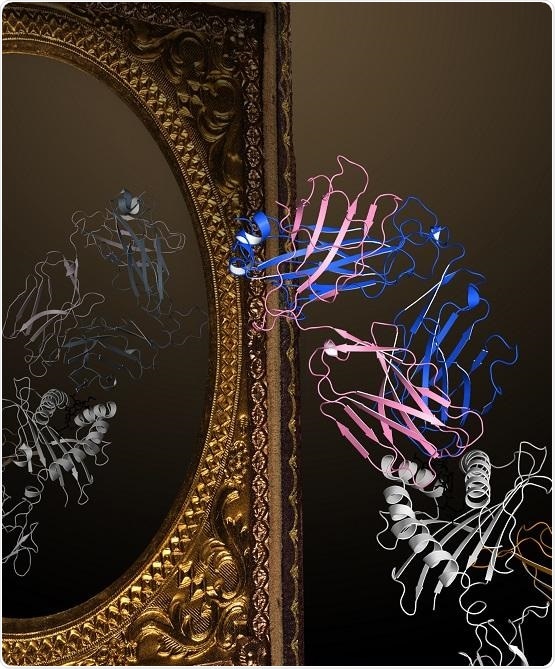Reviewed by Dan Hutchins, M.PhilJun 9 2021
Researchers from Monash University in Australia have made a significant breakthrough relating to how T cells get activated when exposed to pathogens, like viruses.

The image shows a brightly colored canonical interaction between TCR and pMHC which is conducive to signal transduction. The faded mirror image shows a reversed TCR-pMHC interaction which is unable to support signal transduction and thus T cell activation. Image Credit: Dr Erica Tandori (Rossjohn lab).
The new study, published in the Science journal and co-headed by Professor Nicole La Gruta, Professor Jamie Rossjohn, and Professor Stephanie Gras, with the study first author Dr Pirooz Zareie from the Monash Biomedicine Discovery Institute, has discovered that T Cells must recognize pathogens in a specific orientation to receive a strong activating signal.
T cells play an important function in the immune system by removing invading pathogens, like viruses, and it is critical to understand the factors that influence how and why T cells become triggered after identifying these pathogens.
T cells express a T cell receptor (TCR) on their surface that detects and attaches to viral fragments (antigens) presented by infected cells. A recognition event like this has the potential to activate T lymphocytes and destroy infected cells.
The central issue is that there are millions of different T cell receptors (TCRs) in the human body, and a vast array of viruses, making it difficult to understand the rules around how T cell receptor recognition of a virus drives T cell activation. Indeed, it is a problem that has remained contentious for over 25 years.”
Nicole La Gruta, Professor, Monash University
“Our study has shown that the orientation in which the T cell receptor binds is a primary factor determining whether the T cell receives an activating signal,” added Gruta.
“This is an advance in our fundamental understanding of how a T cell needs to 'see' pathogenic antigens in order to be activated. It has clarified a critical mechanism essential for effective T cell immunity. It is also relevant to the ongoing development of immunotherapies that aim to boost the activation of T cells,” Gruta added.
A combination of technologies, including super-resolution microscopy, X-ray crystallography at the Australian Synchrotron, biochemical assays and using in vitro and in vivo experimental models from a variety of labs led to the findings.”
Dr Pirooz Zareie, Monash Biomedicine Discovery Institute
Researchers from the University of Utah, the National University of Singapore, the University of New South Wales, and Monash University collaborated on the project.
Source:
Journal reference:
Zareie, P., et al. (2021) Canonical T cell receptor docking on peptide–MHC is essential for T cell signaling. Science. doi.org/10.1126/science.abe9124.